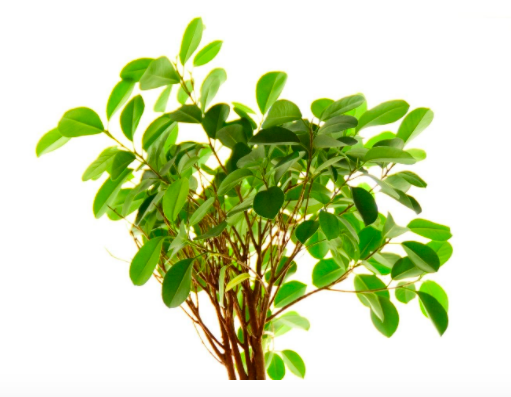
-Pam Scott-
Large tropical trees growing indoors can add a dramatic element to a room like nothing else. A tall green plant can soften the edges of a large space, as it tends to bring together all the different elements of a room’s decor. There are no better plants to do this than plants in the ficus family. There are about 900 species in this family, mulberry (Moraceae), some are deciduous, some evergreen, some tree-like, some vining, most are tropical.
The popular indoor tropical figs share the same family as the fruiting edible figs that can grow outdoors here in zone 7, although their growth requirements are completely different.
Most indoor tropical fig plants require very bright but indirect light. Direct sunlight can tend to scald the leaves of most ficus varieties. They do not like cold or direct drafts, preferring a house temperature between 60-75 degrees. Watering seems to be a major issue with most varieties of ficus. When I tell people, not too much, not too little, but just the right amount, that seems to be clear as mud. I will try to clear some of that up here.
You will want to make sure that your ficus plants have plenty of drainage; the potting medium needs to be slightly barky but still have moisture-holding capacity. Never let your plants sit in water after you have watered them, so empty out your drainage pan. Make sure your ficus is almost completely dry before you water it. I check the soil on top as well as in the drainage holes on the bottom of the plant to determine how moist the soil is throughout the planter.
When you do water your plant, give it a thorough watering, making sure the center of the root ball gets completely rehydrated. If it seems as though the water is going straight through your pot, you may want to soak the plant for a few minutes in a 5-gallon bucket or the sink, if it will fit. One indicator of watering issues with a ficus is the leaves. If the new growth on your plant begins to sag, you have let your plant get too dry. If you are finding browning on the edges, it usually indicates the plant is under-watered or has too low humidity. Brown patches inside the margin of the plant can be an indication of over watering or too low temperatures.
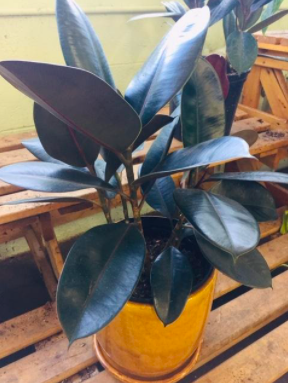
Ficus will drop their leaves when they are unhappy with their care OR if there is a change in their environment. Ficus will often drop some of their leaves when the sun goes higher in the sky in summer and again when the sun lowers and comes directly in the window in winter. They will also drop some lower leaves when they are in active growth in spring when they need to put more energy into new leaf production on top. Try not to move your ficus , as they may be forced to drop their old leaves and regrow new ones with a different cell structure that will accommodate the change in light intensity.
Ficus elastica, also known as the Rubber Tree, is an easy-care ficus with a few interesting varieties such as Ficus burgundy, with deep maroon leaves and Ficus tineke, a lovely variegated variety. Although they are fairly slow-growing, the Ficus elastica can eventually grow up to 8 ft indoors. A Ficus elastica at this height will need staking to keep it upright. Occasional pruning can also help to keep the plant at a desirable height. These plants need plenty of drainage, and a repotting mix of 1 part sterile peat-based potting mix such as Mcenroe Premium Potting Soil mixed with 1 part pine bark will help to keep the plant adequately hydrated while allowing plenty of air circulation to the roots. Fertilize the elastica twice a month with a liquid low dose fertilizer such as Dyna-Gro grow formula. Clean the large shiny leaves often to keep the plant healthy as well as , and check for any insects. Some yellowing and dropping off of the bottom leaves is common in ficus elastica as the plant grows upwards.
Ficus benjamina, also known as the weeping fig, is the most tree-like of the houseplant ficus. It can get very large indoors, reaching up to 10 feet. It enjoys very bright but indirect light but can tolerate a bit of partial morning sun. Over- or under-watering will cause leaf drop. Ficus benjamina prefers filtered tepid water. Always water until water comes out the bottom of the pot. Fertilize this Ficus once a month, giving it a rest time in winter as it goes dormant. This dormancy is a good time to prune this plant, as it can become very large and will probably need some shaping. Ficus benjamina is very susceptible to leaf drop if it is moved. Try to find a favorite place for it and leave it there. When Ficus benjamina does drop all of its leaves, if the growth tips are still pliable and showing some green, don’t panic, it will probably come back.
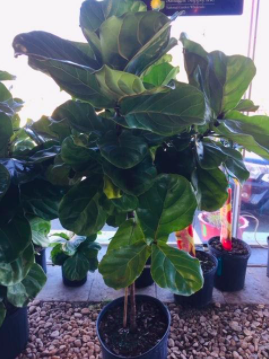
Ficus lyrata (pandurata), also known as the Fiddle Leaf fig, has enjoyed some popularity as a house plant lately. Its huge 12” long violin shaped leaves and its upright growth habit make it a wonderful sculptural focus for a room. It’s a slow growing plant but can reach up to 12‘ indoors. The Ficus lyrata is very sensitive to overwatering, and it enjoys high humidity and a very bright but indirect light source. Keep the room temperature between 60-75 degrees. Fertilize once a month and keep the leaves clean, as the new growth is susceptible to spider mites. You can repot this ficus in the spring with the bark/soil mix, but larger more mature plants can be top dressed with the soil/bark mix yearly.
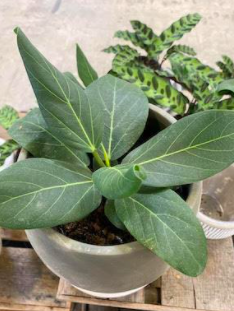
Ficus Audrey is another lovely, soft leaf, tree-like ficus. It is a bit less fussy and easier to care for than the Ficus lyrata. It is more forgiving of less consistent watering and can tolerate less light than the other ficus varieties.
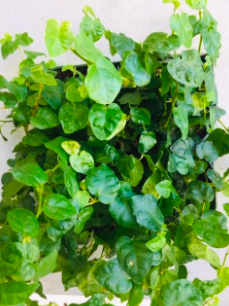
My favorite ficus by far is the Ficus repens (pumila). Unlike the other ficus mentioned here, this plant is a climbing vine. It is fast-growing, often needing to be pruned. It will grow downward in a hanging basket, as well as climb upwards with a trellis. Its tiny heart shaped leaves are adorable, and they also come in miniature as well as variegated varieties. These ficus are easy to care for, tolerating temperatures of 55-75 degrees. They like very bright light but can tolerate direct as well as low light. You can fertilize Ficus repens twice a month. The best thing about Ficus repens is that if you forget to water and you think you have killed it, cut off the dead foliage, keep watering and there is a good chance it will come back.
There are plenty of other Ficus varieties to grow indoors, many of them are well-suited to growing as bonsai plants such as the Ficus microcarpa. Their drought tolerance and need for aerated roots make them well suited for the bonsai pot and growing medium.
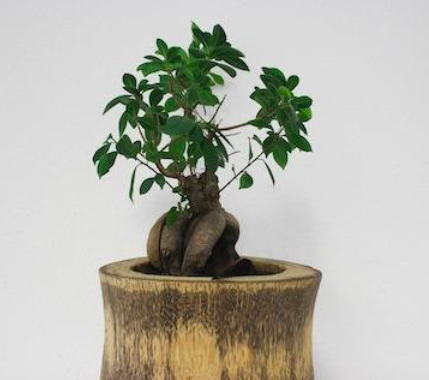
Ficus plants can be prone to mealy bugs, spider mites and scale. The best pest management is to offer your plants the best possible environment to suit their needs. A stressed plant will invite pests and will not have the strength to ward them off effectively. Keeping the leaves clean as well as providing good humidity will help to stave off insects. If, however, you find that you have spider mites on your plants you can wash off the leaves and spray them with Safer insecticidal soap, being sure to cover both sides of the leaves. For scale and mealybugs thoroughly spray your plants with horticultural oil or neem oil every 3 weeks to break the bugs’ life cycles.
Most ficus have latex sap that you can see if you break off a leaf or stem. This is indeed latex. If you have latex allergies be mindful of this when touching the plant and plant debris. Keep your plant-eating pets away from your ficus.
Come on down to Fifth season Gardening and enjoy all the beautiful tropical plants we have in stock. We have everything you will need to keep your indoor garden paradise thriving!

Leave a Reply